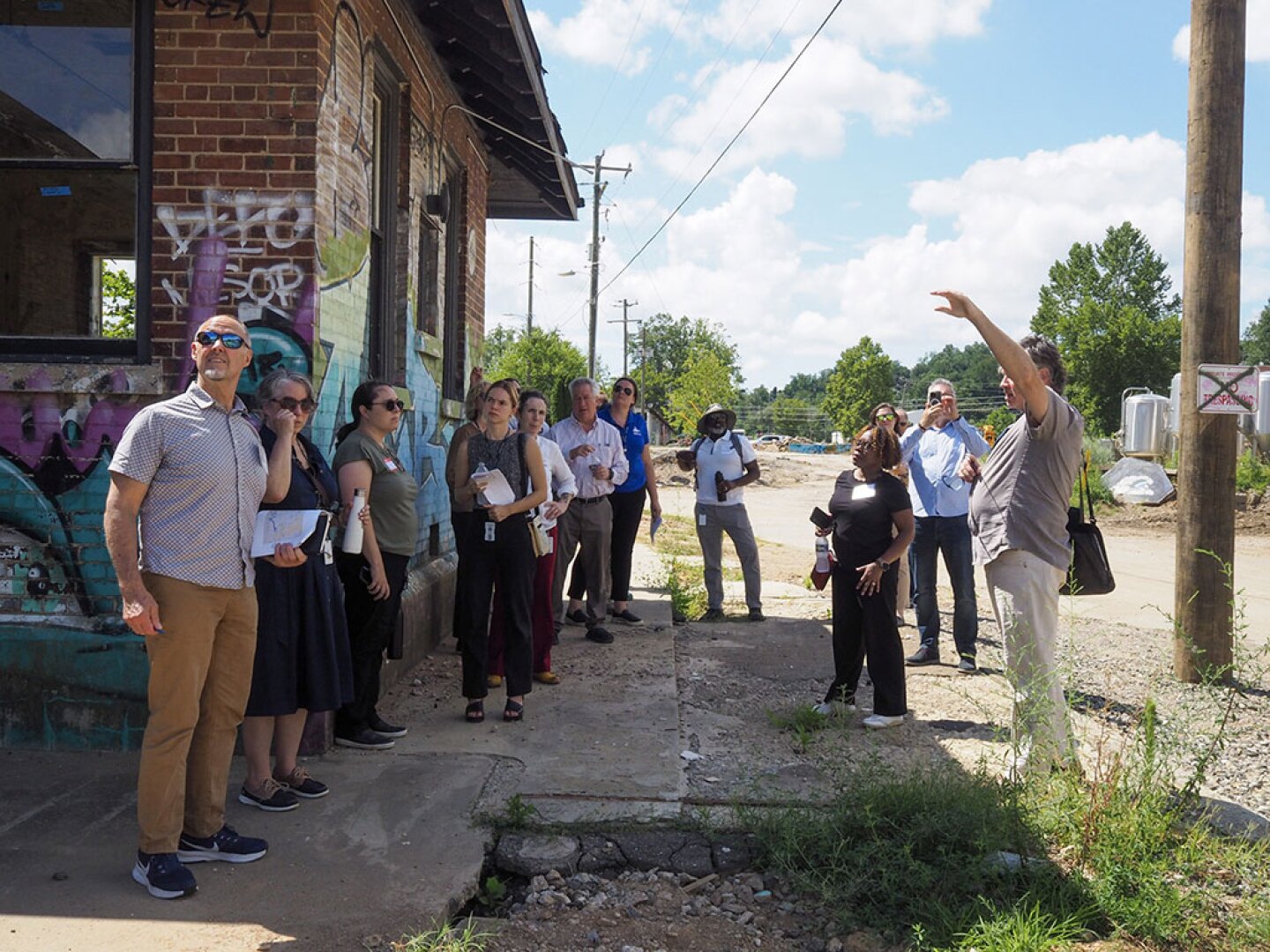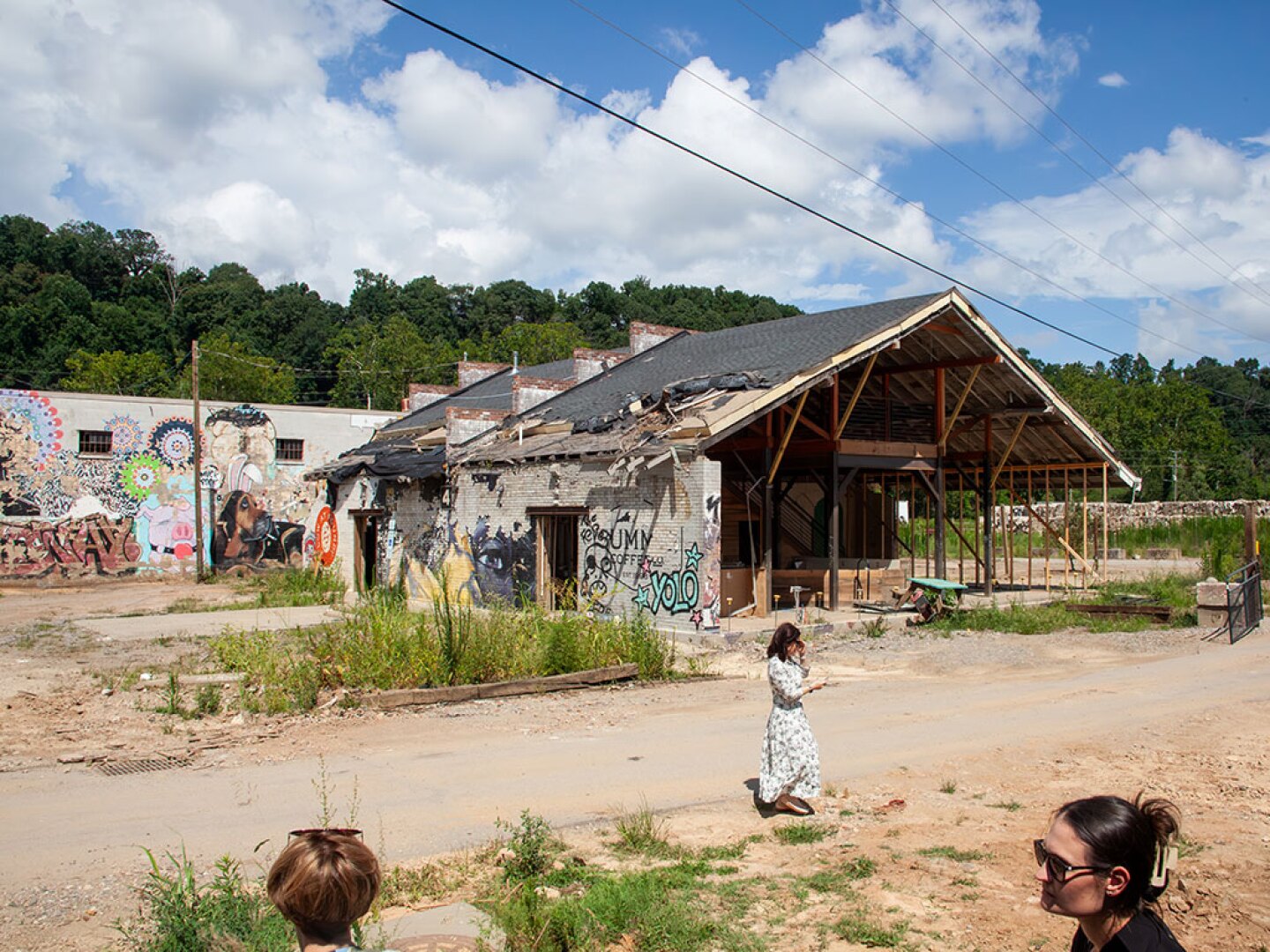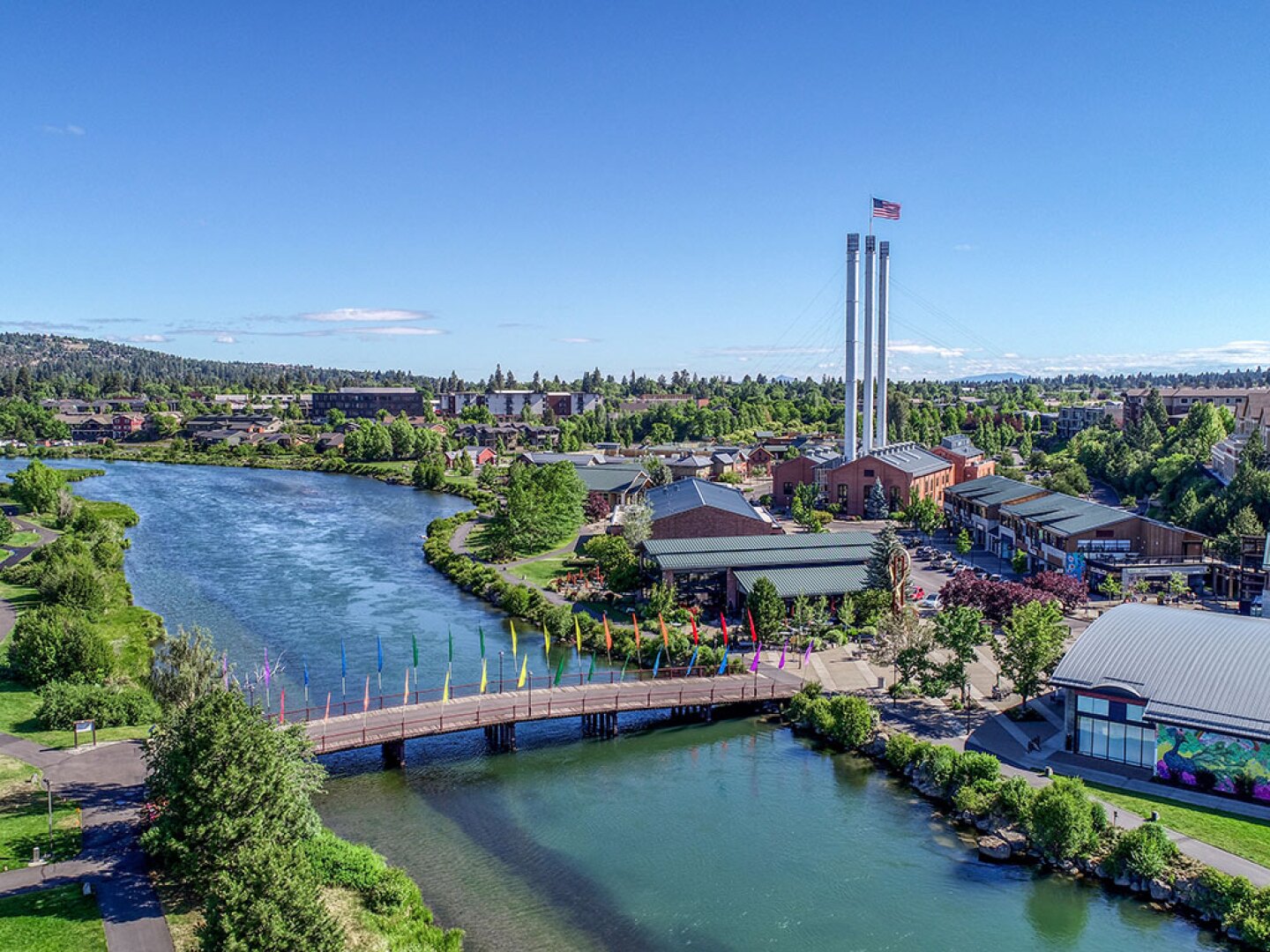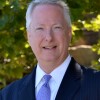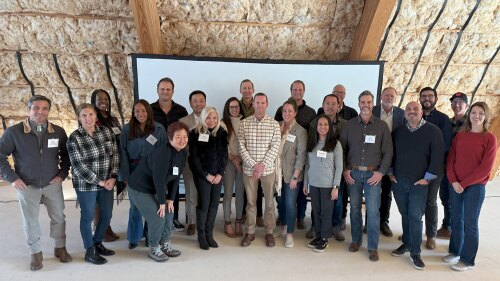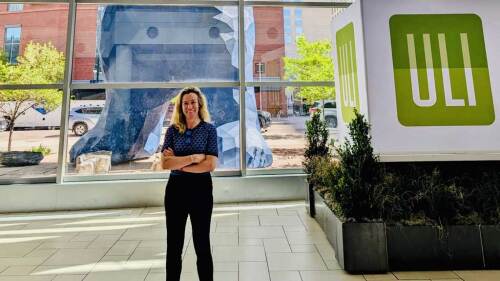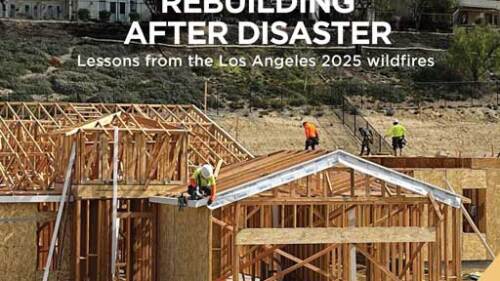In September 2024, Tropical Storm Helene devastated western North Carolina, leaving Asheville with flooded streets, battered infrastructure, and damaged homes. Nearly a year later, the city turned to the Urban Land Institute for guidance, not simply to repair the storm’s destruction, but to seize the moment as a turning point.
For one week in late July 2025, a ULI Advisory Services Panel convened in Asheville. Chaired by James Heid, FASLA, founder of CRAFT DnA and UrbanGreen, the group consisted of Clare De Brière, founder of C+C Ventures in Los Angeles; Andre Brumfield, cities sector leader and principal at Gensler in Chicago; Samia Byrd, director of community planning, housing, and development for Arlington County, Virginia; Roni Deitz, global director of climate adaptation at Arcadis; Richard Green, director of the Lusk Center for Real Estate at the University of Southern California; John Macomber, senior lecturer at Harvard Business School; Jim MacRae, principal with Design Workshop in Denver; and David Mazzuca, lead instructor at Columbia University’s National Center for Disaster Preparedness.
The panel was supported by ULI staff members Aletha Dunston, executive vice president; Victoria Oestreich, a director for the Advisory Services Program; Barbra Gustis, also supporting Advisory Services; Theresa Burnett, executive director of ULI Charlotte District Council; Aimee Witteman, chief impact officer; and Lance Morsell, strategic initiatives lead at ULI Atlanta.
This diverse roster reflected the multifaceted nature of the challenge: Asheville’s recovery was not only about engineering and land use but also culture, economics, and equity. As panel chair Jim Heid noted, the storm’s destruction brought into focus “the strength of the local community networks, and the sheer will to emerge stronger. It might be the rugged individualism that draws people to Asheville, but surviving an event like Helene demonstrates the different playbook places like this require.”
A new framework for resilience
The panel’s charge was to offer strategies that balance Asheville’s identity as a creative hub and outdoor haven with its location on two river corridors prone to repeated flooding. The group’s recommendations touched on infrastructure, equity, housing, economy, and cultural vitality.
One overarching theme was collaboration. “So many of our recommendations will require that the city of Asheville collaborate with its neighboring counties and the state to implement lasting solutions to the flooding issues,” said panelist Clare De Brière. “The city will also need to build bridges amongst its citizens and businesses to find locations to permanently relocate some of those most special uses from the floodplain onto higher ground and use those flood zone areas with low-impact developments geared toward community uses.”
Panelist John Macomber added that the storm’s aftermath presented a unique chance: “In the Asheville context, the aftermath of a tragic storm wound up leaving something of a blank slate that could be addressed—with private, state, and FEMA support—to do something forward-thinking and great. Not just ‘build back same’ but ‘build back with an urban plan so it’s better for the whole community.’”
The panel urged Asheville’s leaders to see Helene not as a lasting scar but as a catalyst for a “legacy of resilience.” Federal disaster recovery dollars, although temporary, provide an unprecedented opportunity to reshape the city’s future. Local leaders were encouraged to act boldly and swiftly, embracing innovation and being unafraid of failure.
Recommendations
A central recommendation was to expand park space along the French Broad River and Swannanoa River corridors. Building on Asheville’s long history of green space, from the Biltmore Estate to city parks, the panel argued that new riverfront parks would serve as both flood buffers and community amenities. Restored riparian buffers, enhanced biodiversity, and expanded recreation would improve physical resilience while signaling a new era of civic pride.
Equity was at the heart of many recommendations. The city’s Black population has declined in recent years, a trend worsened by the storm’s displacement. The panel called for targeted investments in historically Black neighborhoods, improving access to parks, supporting Black entrepreneurship, expanding affordable housing, and enhancing the Black Cultural Heritage Trail.
Such investments, panelists argued, would not only honor history but also build a more resilient community. As the panel noted, retaining and growing Asheville’s Black populace strengthens the social fabric against environmental and economic stressors.
Another cornerstone recommendation was a One Water approach, recognizing that drinking water, wastewater, stormwater, and natural waterways are interconnected. Recommendations included creating a One Water Council to align city and county agencies, launching a countywide stormwater master plan, and upgrading critical infrastructure. Restoring natural floodplains and riparian buffers was emphasized as a cost-effective, long-term resilience strategy.
Economy built on resilience
Although tourism, arts, and recreation remain cornerstones of Asheville’s economy, the panel warned against replicating past models without regard to risk. Instead, they urged building an economy designed for resilience:
- Tourism as stewardship: Reframe tourism with greater resident input and a focus on shared community value
- Recreation economy: Reimagine the riverfront as both an economic engine and a civic gathering place
- Creative entrepreneurs: Use disaster relief funds to incubate local businesses tied to Asheville’s cultural identity
- Workforce development: Train residents in green construction, climate resilience, and clean energy to prepare for a sustainable economic future
Housing, zoning, and development
Housing was framed as essential to resilience. Although Asheville has produced housing at more than twice the national rate, affordability pressures persist. High mortgage rates and construction costs challenge new supply. The panel recommended reframing housing policies and incentive programs to better match market realities.
The panel also suggested creating two new zoning districts:
- River District Floodplain Zone (RDFZ): Restrictive rules to minimize incompatible development in floodplains, with requirements for stormwater management and conservation
- River District Mixed Use Zone (RDMUZ): Encouraging multifamily housing and mixed uses outside the floodplain, with density bonuses for affordability and space for artists
Ultimately, property owners will need to consider the risk, readiness, and resources available to them before making decisions about whether to rebuild in the floodplain. For all vulnerable properties, the panel offered five main options: reinforce, rebound, relocate, restrict, or rebuild the same.
To help developers navigate new requirements, the panel proposed a dedicated development liaison as a single point of contact within city government to streamline permitting and advocate for projects aligned with resilience goals.
Culture as core identity
The panel recommended finding safer locations outside the floodplain for Asheville’s artists, noting that arts and culture are essential to the city’s identity. As Jim Heid explained, “Seeing what the River Arts District had become through the years illustrated to me that arts and culture is not a ‘luxury’ but an essential element of identity, personality, and civic pride for the places where they flourish. The challenge now will be to rebuild the ethos and spirit of the River Arts District for the benefit of the broader community.”
The panelists repeatedly emphasized that recovery would hinge on partnerships between public and private sectors, across jurisdictions, and among community groups. They also highlighted the role of grassroots networks that had already proven their worth during the storm. As Heid observed, “Hearing the stories of what the community endured and the creative grassroots solutions they developed to overcome comes down to the strength of the people who live there, the bonds they hold for others’ survival, and their willingness to pitch in during times of extreme duress.”
Time, the panel stressed, is of the essence. Federal recovery funds are finite, and public attention can fade. To sustain momentum, they proposed clear benchmarks, metrics, and accountability systems, tracking investments in people, nature, and community across short-, medium-, and long-term horizons. “This moment will be defined not by what the city has been, but also what the city will become,” the panel concluded.
Looking forward
For Asheville, the storm’s devastation was a painful reminder of vulnerability, but also an invitation to rethink its future. The ULI panel’s guidance, rich with lessons from across the country, offers a roadmap to resilience that blends infrastructure improvements, cultural preservation, economic innovation, and social equity.
As Macomber framed it, the stakes are both local and national: “There will be many American cities facing highly unusual river flooding from time to time, even though they aren’t imperiled by coastal concerns like sea level rise or wildfire. Identifying and reinforcing those assets, or relocating those people and uses, or just having a much better early warning and rescue system in place will benefit all of them.”
In Asheville, the work ahead is clear. What remains to be written is whether the city will seize this rare opportunity, not just to recover but also to emerge as a model of resilience for communities nationwide. The ULI panel’s final report, incorporating community feedback and detailed strategies, is expected to be released in early 2026.
This work was made possible through the support of the ULI Foundation and the generosity of ULI members, whose expertise, engagement, and philanthropic contributions help bring important community efforts like this one to life.

